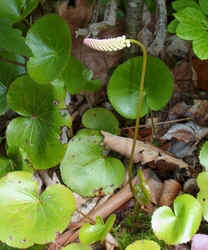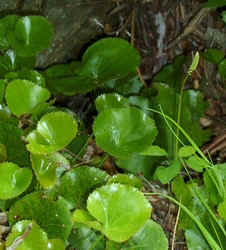 |
 |
Common Name: Galax
Scientific Name: Galax aphylla
Family: Diapensiaceae
Blue Ridge Parkway
North Carolina
June 1, 2002
 |
 |
The leathery, 3 -4 inch wide leaves of these low, rhizomatous perennials turn reddish brown or bronze in the winter and are often used in Christmas decorations. The flower stalk is usually 18 - 24 inches tall. Native to the southern Appalachian region but cultivated elsewhere, Galax grows in open, often rocky, deciduous woods in our mountains and, less frequently, in the piedmont and coastal plain. May - July [Justice, William S. and Bell, C. Ritchie, Wild Flowers of North Carolina. University of North Carolina Press, Chapel Hill, 1968]
Whatever the season, galax will reward you with its beauty. In the early spring, its round, evergreen leaves carpet the dormant forest floor. By summer, a tall pillar of tiny white flowers lines many park trails. Then, as winter approaches, the deep green leaves turn bronze and crimson to contrast against the coming snows. Galax comes from the Greek gala, meaning milky. This refers to the five milky-white petals of the tiny flowers. Their garlic-like odor attracts flies and other insect pollinators. Galax grows vigorously after forest fires. Galax occurs only in the southern Appalachians and was once in peril because of over-collection for floral arrangements. May - June [White, Peter, Wildflowers of the Smokies. Great Smoky Mountains Natural History Association, Gatlinburg, 1996]
Galax is most noticed by its long-stalked, roundish, heart-shaped, and shiny leaves. They measure 1 to 3 inches across and have small bristly teeth along the edges. During the summer months, patches of galax carpet the forest floor with these bright green leaves. During the winter months the leaves become reddish or bronze. The tiny white flowers, which start to appear in May, are arranged in narrow, spike-like clusters on a naked, 10- to 18- inch, wand-like stalk. This results in the plant often being called the wandflower. This attractive southern wildflower is found only in the Southern Appalachians. The generic name Galax is derived from the Greek word, gala, meaning "milk", and refers to the milky white color of the flower. This is a native plant of the rich, moist woods of the Blue Ridge Mountains. [Alderman, J. Anthony, Wildflowers of the Blue Ridge Parkway. The University of North Carolina Press, Chapel Hill, 1997]
January February March April May June July August September October November December
Alphabetical Listings -- A B C D, E F G H I, J, K L M N, O P Q, R S T U, V W X, Y, Z
Family Listings -- A B C D, E F G H I, J, K L M N, O P Q, R S T U, V W X, Y, Z
Genus Listings -- A B C D, E F G H I, J, K L M N, O P Q, R S T U, V W X, Y, Z